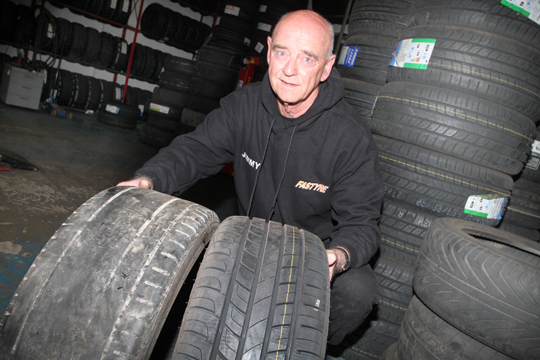With the price of motoring rising, one in ten motorists are choosing to purchase part-worn tyres, rather than new tyres. It is understandable that during these financially difficult times that people will try and save money where they can.
Unfortunately, when deciding to relieve the pressures on the bank balance with the purchase of part worn tyres, motorists may be taking an unnecessary and potentially dangerous risk.
[caption id="attachment_52417" align="aligncenter" width="540"] Jimmy McDonald of Jimmy Fastyre shows off a badly worn tyre on the left and a legal one on the right.[/caption]
Jimmy McDonald of Jimmy Fastyre shows off a badly worn tyre on the left and a legal one on the right.[/caption]
In 2013, Environmental Health Officers across the 26 District Councils in Northern Ireland took part in a survey exercise to assess part worn tyre retailers compliance with the Motor Vehicle Tyre (Safety) Regulations 1994 (as amended). In December 2012, 18 District Councils purchased 37 part-worn tyres for testing and this is what they found:
* 92% (34 out of 37) of all part-worn tyres tested failed to meet fully the requirements of The Motor Vehicle Tyre (Safety) Regulations 1994 (as amended)
* 57% (21 out of 37) of part-worn tyres tested failed with regard to labelling alone.
* 22% (8 out of 37) of all part-worn tyres tested failed to meet the requirements of Section 7(5) ‘the grooves of the original tread pattern of the tyre must be of a depth of at least 2 millimetres across the full breadth of the tread and round the entire circumference of the tyre’.
* 22% (8 out of 37) of all part-worn tyres tested failed to meet the requirements of Section 7(2) ‘the tyre must not have – * any cut in excess of 25 millimetres or 10 per cent of the section width of the tyre, whichever is the greater, measured in any direction on the outside of the tyre and deep enough to reach the ply or cord; * any internal or external lump, bulge or tear caused by separation or partial failure of its structure; * any of the ply or cord exposed internally or externally; * any penetration damage which has not been repaired.
A number of part worn tyres (3 out of 37 or 8%) tested fully complied however despite previous advice provided as part of the survey undertaken in September 2012 the test purchase exercise has revealed that the vast majority of part worn tyres sampled failed to comply with The Motor Vehicle Tyre (Safety) Regulations 1994 (as amended).
Jimmy McDonald, of Jimmy Fastyre in Downpatrick explained: “If you buy second hand tyres and they do not carry a proper stamp, you may be compromised if you have an accident and the insurance assessor notes this. It could prove to be very expensive in the long-term.”
A staggering 35% (13 out of 37) of all part-worn tyres tested had serious faults that would potentially affect the safety of the tyre. Using this information a number of councils instigated legal proceedings with retailers receiving fines of approximately £100 for each offence.
All sellers of part-worn tyres should take positive steps to ensure that all part-worn tyres they stock for supply meet the requirements of the regulations and ensure that all relevant staff are made aware of these requirements.
For further information on tyre safety motorists should visit the following website:
Due to the significant number of faults found in part worn tyres sampled District Council Environmental Health Departments will continue to sample and test part worn tyres as part of work plans this has been organised to begin again shortly.
Part worn tyres will be tested in accordance with the requirements of the regulations.
]]>

























